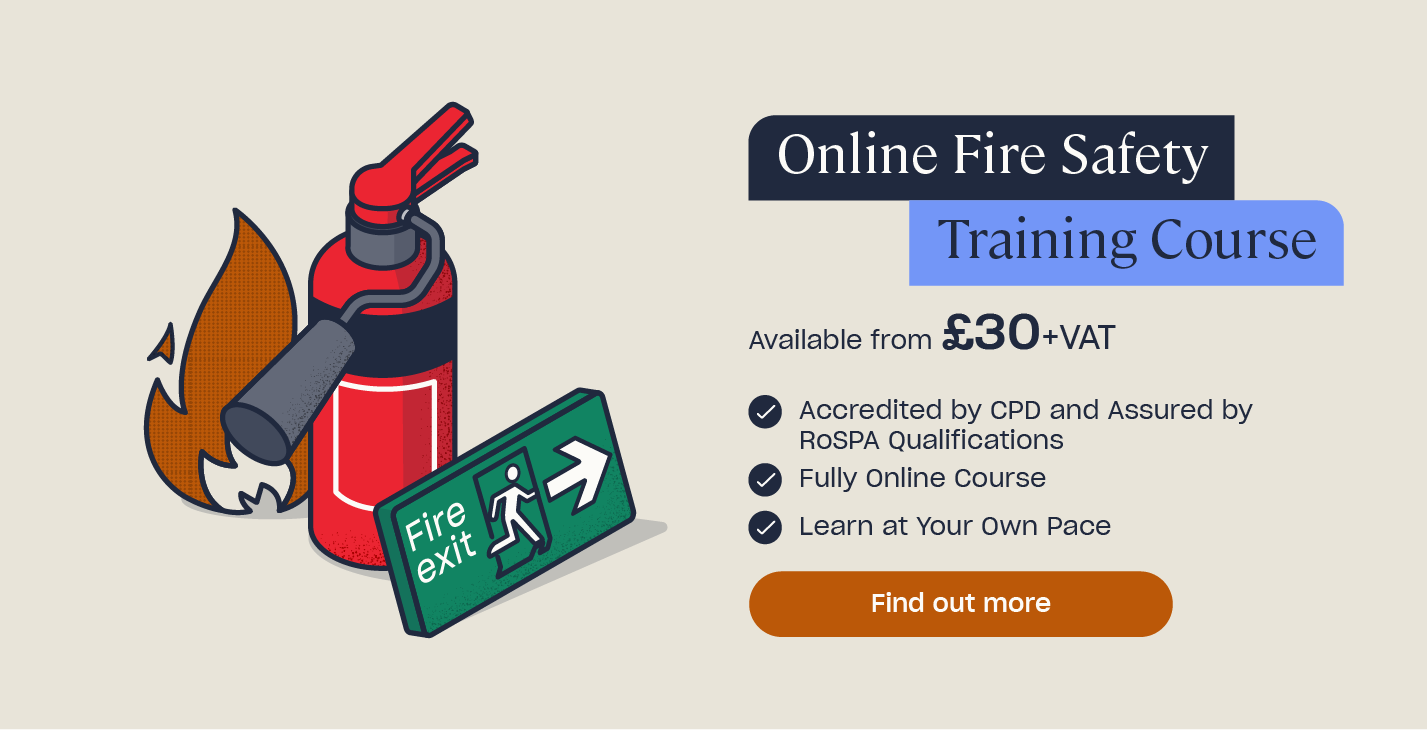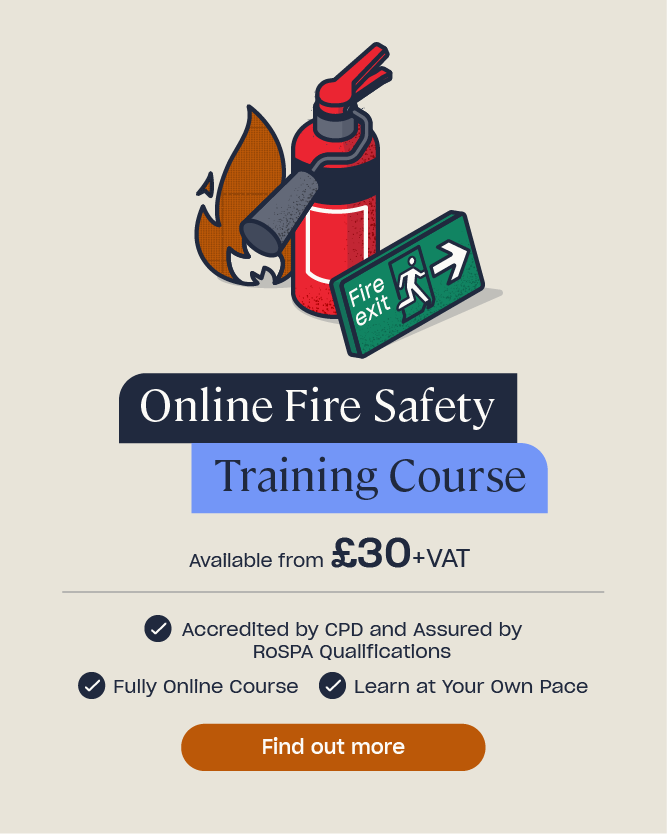Fire Safety Signs
Legislation states that everyone within the workplace must be provided with relevant fire safety information. In regards to fire safety signs, this means that everyone must be aware of the location of fire alarms and emergency equipment, as well as understand where the fire exits are located and how to access them safely.
The individual requirements for your premise’s fire safety signs will be determined by your business’ individual risk assessment – however, this short guide to fire safety signs introduces the main signage available and shows you in which situations they should be displayed.
Why are Fire Safety Signs Important?
The Regulatory Reform (Fire Safety) Order 2005 states that all workplaces must have adequate safety signs to point people towards fire-fighting equipment, emergency routes and emergency exits. Primarily, they are used to warn and instruct employees of risks to their health and safety.
This legal requirement is vital because, without proper signage, you are potentially putting employees’ lives in danger. Under health and safety law, all employers have a legal responsibility to ensure the health and safety of their employees whilst at work: fire safety signs are just one of the many things that you can do to comply with this requirement.
Want to Learn More?
Our Fire Safety Training explains legal responsibilities, common causes of fires, how to prevent them, what fire safety arrangements are necessary, and the importance of following emergency procedures. We also offer Fire Extinguisher Training and Fire Warden Training.
What are The Rules on Fire Safety Signs?
The following tips for fire safety signs, as stated in the Health and Safety (Safety Signs and Signals) Regulations 1996, provide some guidance on which signs should be used and how and where they should be displayed:
- Fire safety signs should always be clear and unambiguous – ensure that fire safety signs are used to clearly and effectively indicate the escape routes and exits in case of fire.
- Escape routes and doors must be obviously labelled – any door that could be confused with an emergency exit door should be marked clearly with a sign or notice reading ‘no exit’, ‘no way out’ or labelled with their use, such as ‘storeroom’. If you want to learn more about fire door safety, you can find further guidance here.
- Escape route signs must be displayed all along the exit route – signs should be placed at all changes of direction in corridors, stairs or open spaces as well as above all doors or junctions.
- Fire safety signs should be illuminated – this ensures that they can always be seen and be legible, including in conditions where the power is lost.
- Direction arrows should be included on escape route signs to indicate the quickest route to safety – wherever you are in a building, it is important that you can immediately see a sign for the nearest fire escape route. Directional arrows are included on each sign to point towards the more efficient route out.
- Final fire exit signs should not have arrows on – emergency exit signs above the final exit door should not feature arrows. Instead, they should have the image of a running man and can be supplemented by the words ‘exit’ or ‘fire exit’.
- Fire escape route signs should be in picture form with supplementary text. signs need to be suitable for use by everyone, including those who have poor vision, suffer from dyslexia or do not have English as their first language. Supplementary text will also ensure that the graphical symbol’s meaning is fully understood. The Equality Act 2010 further says that you must make ‘reasonable adjustments’ for the disabled, including displaying braille and tactile fire safety signage alongside the standard picture signs.
- Signs should be positioned at an appropriate height – signs need to be visible from a distance (full guidance on which can be found from the British Standards Institute in the document BS 5499 Part 4). Signs above doors should be 2m from the floor or 2m down when suspended from the ceiling and wall signs should be 1.7m from the floor.
- Businesses should teach their employees about the different fire extinguishers available in the workplace – a diagram of the different types of fire extinguishers and information about the 6 classes of fire symbols that appears on them is featured below.
- All employees should know the location of the nearest fire alarm and what to do in an emergency – this is a legal requirement and can be done by training staff, using ‘fire alarm call point’ signage and displaying a Fire Action Notice sign in a visible place.
- Fire-fighting equipment must be identified with signs – for example, signs indicating the location of a fire hose reel or extinguisher.
What are the Categories of Fire Signage?
Fire safety signs are used to provide health and safety information, either to warn you of a hazard, to provide an instruction or to give you safety information. Safety signs can be a variety of colours – usually red, green, yellow or blue – and may contain images, words or a mixture of the two. It’s essential that you adhere to the fire safety signs in your workplace and any other public space: they are there for your safety and ignoring them could have serious consequences.
Which Fire Safety Signs are Needed for Fire-Fighting Equipment?
Article 13 of the Regulatory Reform (Fire Safety) Order 2005 states that any non-automatic fire-fighting equipment provided should be easily accessible, simple to use and indicated by signs. The signs used are as follows:
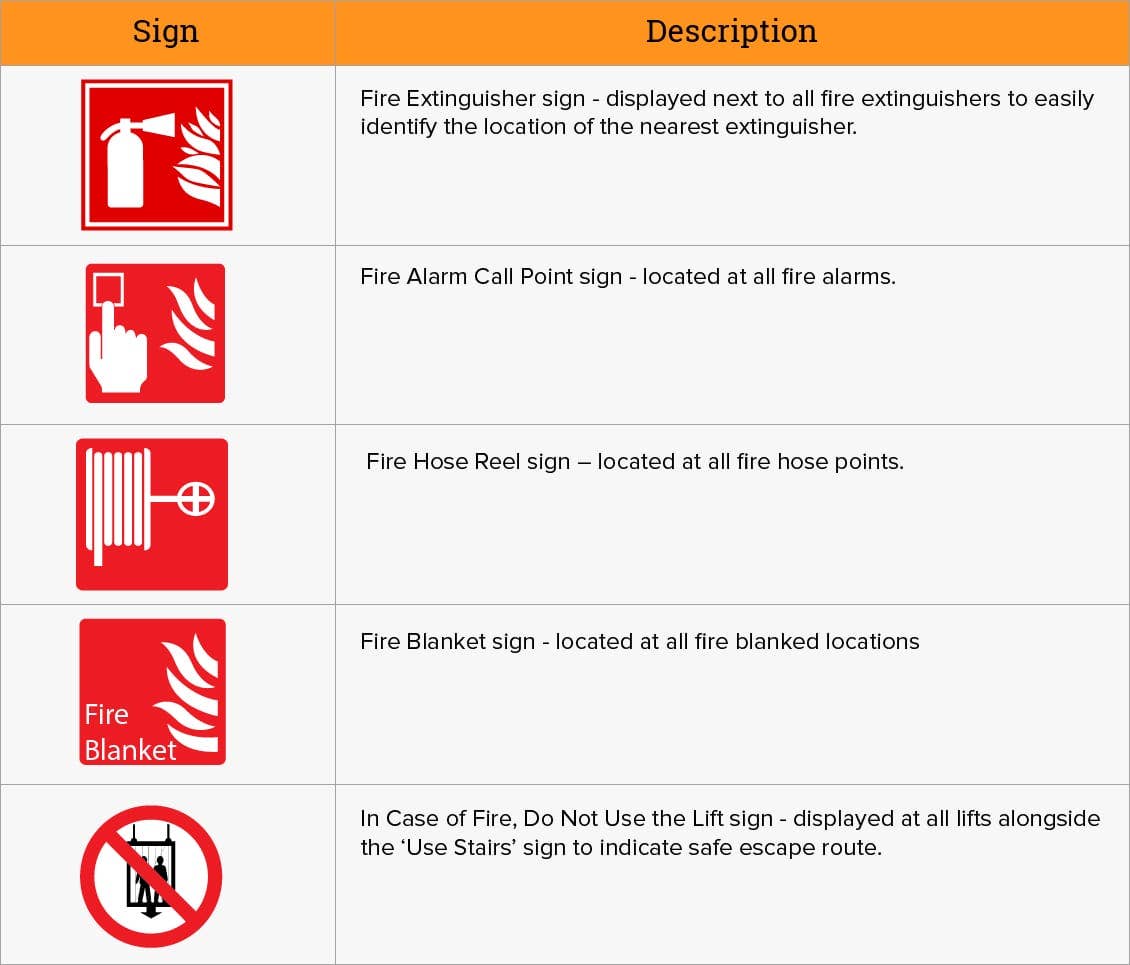
Which Fire Safety Signs are Needed for Emergency Exits?
Article 14 of the Regulatory Reform (Fire Safety) Order 2005 states that ‘emergency routes and exits must be indicated by signs.’ The signs used are as follows:
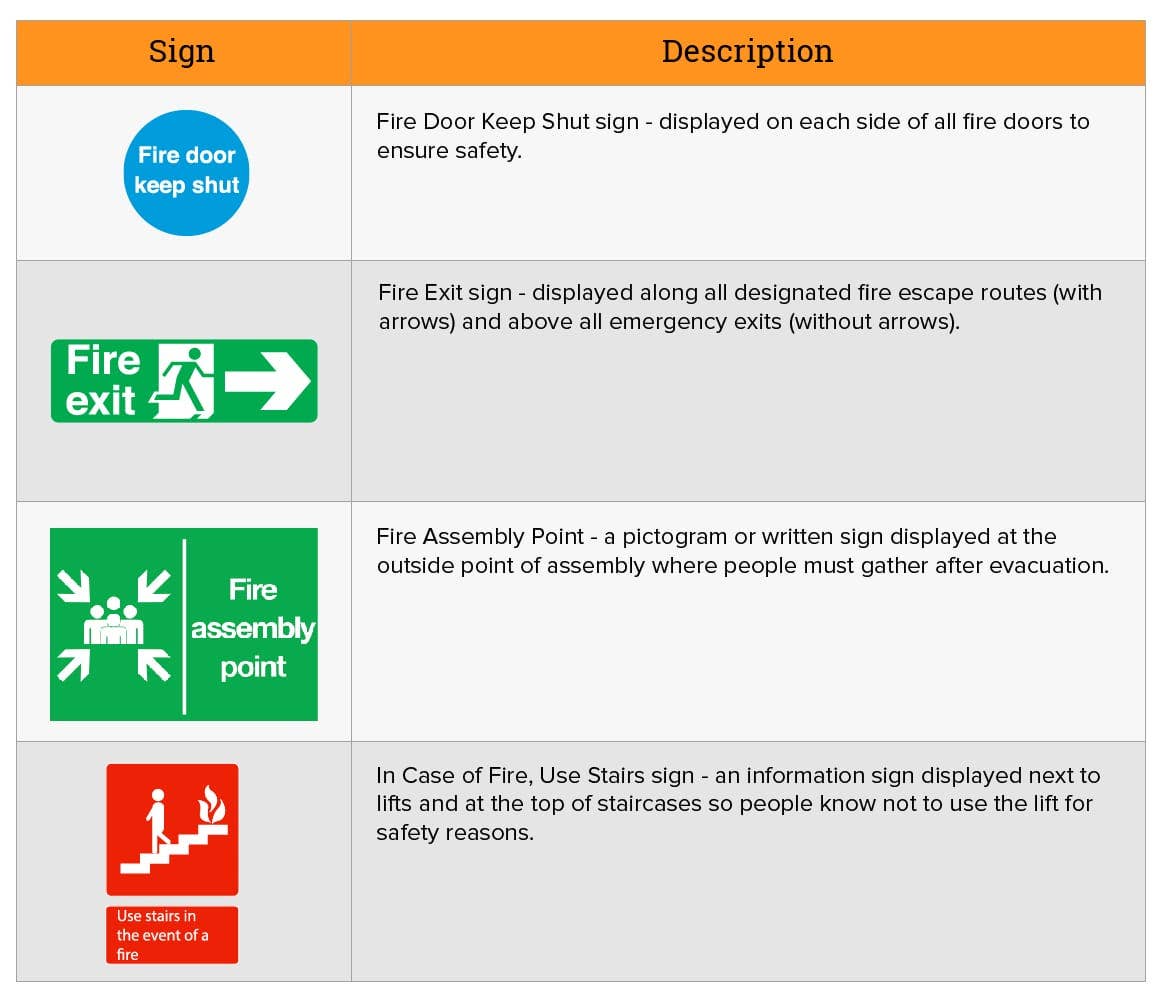
Fire exit signs feature directional arrows which show the safest and quickest emergency route, as seen by the diagram below. Note that the final fire exit sign, displayed above the emergency exit door, should not display a directional arrow.
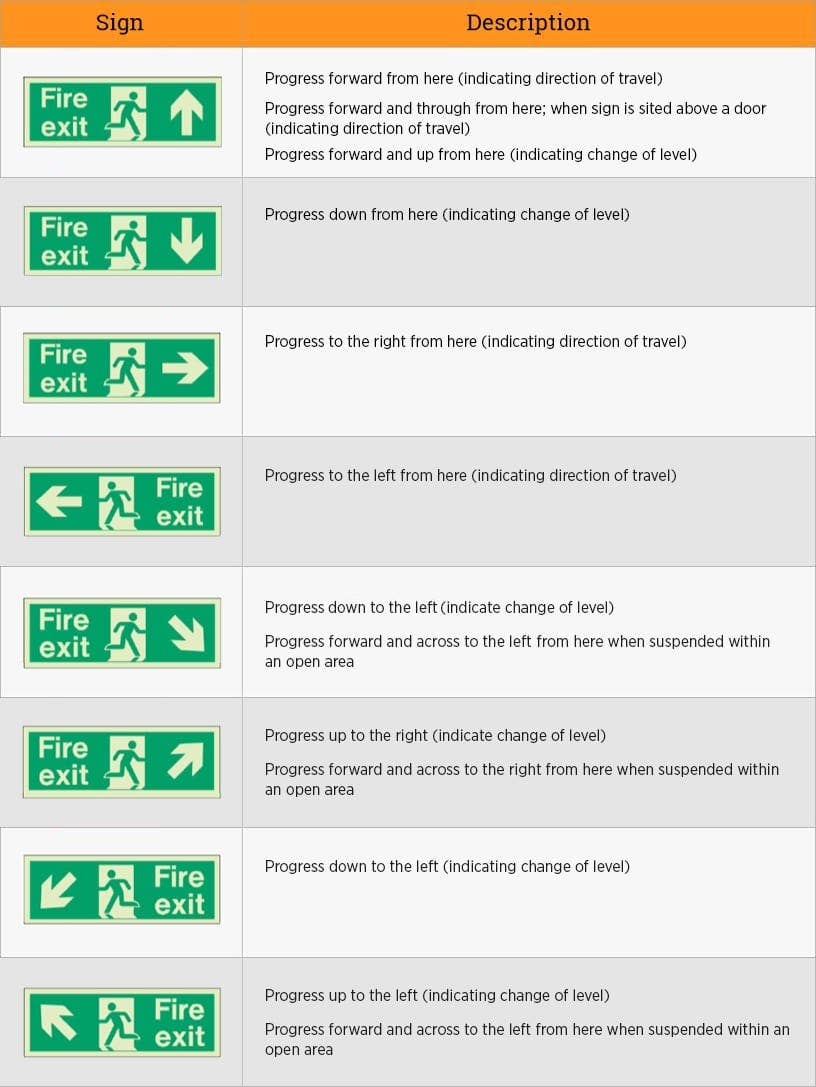
Why is the Fire Exit Sign Green?
In the UK, fire exit signs are coloured green and white as this colour combination signifies a safe condition. They must feature a pictogram of the ‘rapidly walking man’ and an arrow. Some green fire exit signs will also feature the ‘fire exit’ text in lower case letters. These requirements are set by BS 5499.
What do Blue Fire Safety Signs Mean?
In the UK, blue fire safety signs are used to indicate a mandatory action. These blue signs require you to carry out an action in order to contribute towards your safety and must be coloured this way according to BS 5499. Blue fire safety signs are circular in shape and feature a white graphic or white text.
What do Red Fire Safety Signs Mean?
In the UK, red fire safety signs are used to indicate prohibition, the location of fire equipment, and supplementary information. Red prohibition signs are circular with a red border, white background and black image and warn you of what not to do in order to maintain safety. Fire equipment signs are square with red background and white images and are used to indicate the location of fire-fighting equipment.
How are Fire Extinguishers Labelled?
Fire extinguishers should be identified using the correct fire safety signage so that people can easily recognise their location in an emergency. The sign (a picture of a white extinguisher on a square, red background) should be clearly displayed next to every extinguisher location.
All fire extinguishers also feature symbols relating to the classes of fire it is designed to combat. It is essential to pay attention to these signs, as using a fire extinguisher on a class of fire which it is not designed for can be deadly.
They also have symbols that accompany the instructions for usage, e.g. to show you in which direction you should pull out the safety pin.
What are the different classes of fire?
Fires must be fought carefully depending on the materials involved. That is why they have been classified in 6 different categories:
- Class A – Fires that involve solid or organic materials, such as wood, plastics, paper, textiles, or coal.
- Class B – Fires that involve flammable liquids, such as gasoline, petroleum oil, paint, or diesel.
- Class C – Fires that involve flammable gases, such as propane, butane, or methane.
- Class D – Fires that involve combustible metals, such as magnesium, lithium, sodium, potassium, titanium, or aluminium.
- Although it is not recognised as a separate class of fire in Europe, electrical fires that involve live equipment and electrical sources are also a type you should bear in mind (think of it as an informal Class E).
- Class F – Fires that involve cooking oils and fats, such as vegetable oil, sunflower oil, olive oil, maize oil, lard, or butter (typically those used for deep-fat fryers).
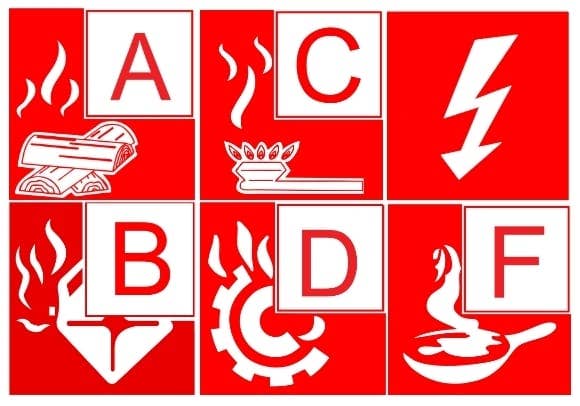
Each type of fire extinguisher contains different materials that make them suitable for fighting certain types of fires, and the symbols printed on each extinguisher’s cylinder shows you exactly which types of fire it’s suitable for.
There are five main types of fire extinguishers:
- Water.
- Powder.
- Carbon Dioxide.
- Foam.
- Wet Chemical.
You must use the correct type of fire extinguisher for the type of fire. For example, you must only use a powder or carbon dioxide extinguisher on an electrical fire.
You can find full information on Fire Extinguishers and their usage in this guide: Understanding the Different Types and Uses of Fire Extinguishers
What is a Fire Action Notice Sign Used For?
The purpose of a fire action notice is to inform employees of what to do in the event of a fire. The emergency services phone number, nearest exit point and safe assembly point must be filled in for each location where the notice is used.
The notice should be displayed in all workplaces, next to all fire alarm call points and in areas accessible to all employees (such as the staff room or entrance to each working area). See the example of what a fire action notice looks like below:
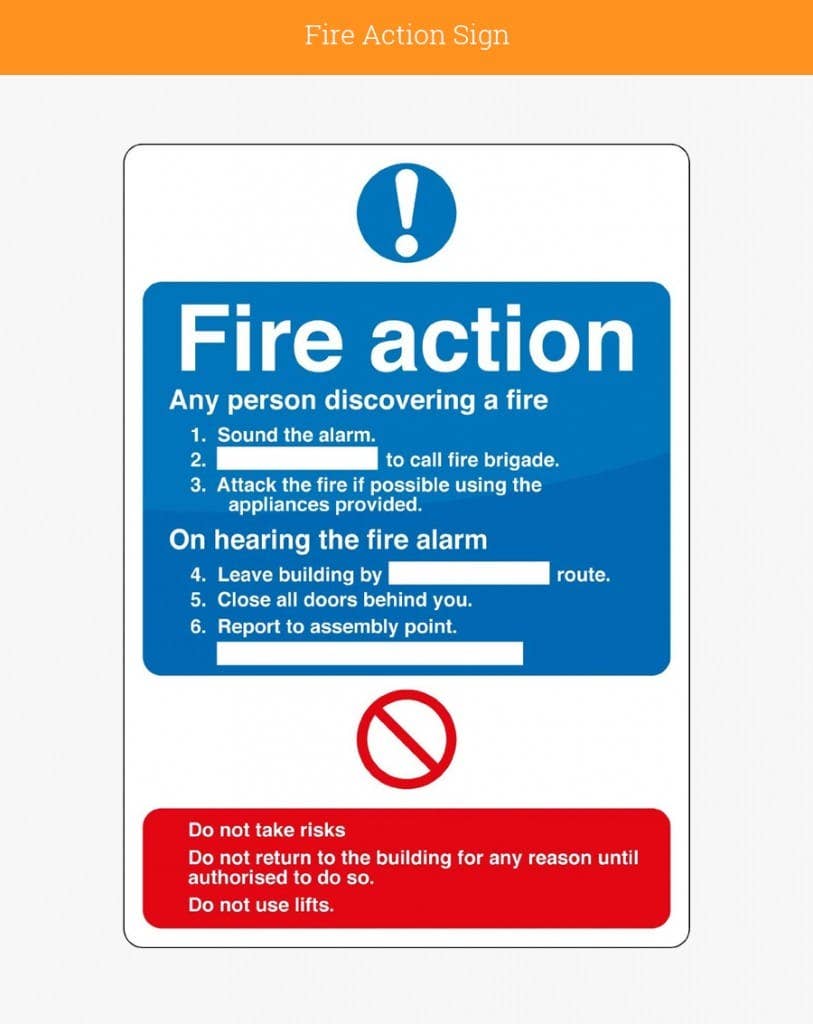
Further Resources:
- Fire Safety Quiz
- Information about the Fire Triangle & Combustion
- What to Include in a Fire Safety Evacuation Plan
- Top 10 Fire Safety Tips in the Workplace
- Fire Safety Training


